The Study of Gaining More Detailed Variability Information of Soil Organic Carbon in Surface Soils and Its Significance to Enriching the Existing Soil Database
Abstract
:1. Introduction
2. Materials and Methods
2.1. Study Area
2.2. Soil Sampling and Laboratory Analysis
2.3. Calculation of the SOC Contents and Stocks
2.4. Calculation of the SOC Contents and Stocks in the Sub-Layers of Topsoil Using the Equal-Area Spline Model
2.5. Spatial Interpolation and Evaluation of its Accuracy
2.6. Statistical Analysis Software
3. Results
3.1. Mean SOC Contents and Stocks in Every 5-cm-Thick Sub-Layer of Topsoil
3.2. SOC Contents and Stocks in the 0–5, 5–10, and 10–15 cm Sub-Layers
3.3. Geostatistics Analysis of the SOC Contents and Stocks in the Various Sub-Layers
3.4. Interpolation Maps and Accuracy Evaluation of the Various Sub-Layers
4. Discussion
4.1. Differences in SOC Contents and Stocks among the Sub-Layers within the Topsoil
4.2. Ecological Significance of Revealing the Differences in the SOC of Each Sub-Layer
4.3. Significance for Enriching the Existing Soil Database
5. Conclusions
Author Contributions
Acknowledgments
Conflicts of Interest
References
- Lal, R. Soil carbon sequestration to mitigate climate change. Geoderma 2004, 123, 1–22. [Google Scholar] [CrossRef]
- Minasny, B.; Malone, B.; McBratney, A.B.; Angers, D.; Arrouays, D.; Chambers, A.; Chaplot, V.; Chen, Z.-S.; Cheng, K.; Das, B.S.; et al. Soil carbon 4 per mille. Geoderma 2017, 292, 59–86. [Google Scholar] [CrossRef]
- Xue, R.; Yang, Q.; Miao, F.; Wang, X.; Shen, Y. Slope aspect influences plant biomass, soil properties and microbial composition in alpine meadow on the Qinghai-Tibetan plateau. J. soil Sci. Plant Nutr. 2018, 18, 1–12. [Google Scholar] [CrossRef]
- Odgers, N.; McBratney, A.B.; Minasny, B. Bottom-up digital soil mapping. I. Soil layer classes. Geoderma 2011, 163, 38–44. [Google Scholar] [CrossRef]
- Odgers, N.; McBratney, A.B.; Minasny, B. Bottom-up digital soil mapping. II. Soil series classes. Geoderma 2011, 163, 30–37. [Google Scholar] [CrossRef]
- Iwasaki, S.; Endo, Y.; Hatano, R. The effect of organic matter application on carbon sequestration and soil fertility in upland fields of different types of Andosols. Soil Sci. Plant Nutr. 2017, 63, 200–220. [Google Scholar] [CrossRef] [Green Version]
- Alavaisha, E.; Manzoni, S.; Lindborg, R. Different agricultural practices affect soil carbon, nitrogen and phosphorous in Kilombero-Tanzania. J. Environ. Manag. 2019, 234, 159–166. [Google Scholar] [CrossRef]
- Witing, F.; Gebel, M.; Kurzer, H.-J.; Friese, H.; Franko, U. Large-scale integrated assessment of soil carbon and organic matter-related nitrogen fluxes in Saxony (Germany). J. Environ. Manag. 2019, 237, 272–280. [Google Scholar] [CrossRef]
- Hateffard, F.; Dolati, P.; Heidari, A.; Zolfaghari, A.A. Assessing the performance of decision tree and neural network models in mapping soil properties. J. Mt. Sci. 2019, 16, 1833–1847. [Google Scholar] [CrossRef]
- Park, S.; Vlek, P. Environmental correlation of three-dimensional soil spatial variability: A comparison of three adaptive techniques. Geoderma 2002, 109, 117–140. [Google Scholar] [CrossRef]
- Malone, B.; McBratney, A.B.; Minasny, B.; Laslett, G. Mapping continuous depth functions of soil carbon storage and available water capacity. Geoderma 2009, 154, 138–152. [Google Scholar] [CrossRef]
- Wang, M.; Wang, Q.; Sha, C.; Chen, J. Spartina alterniflora invasion affects soil carbon in a C3 plant-dominated tidal marsh. Sci. Rep. 2018, 8, 628. [Google Scholar] [CrossRef] [PubMed]
- Jacinthe, P.-A.; Shukla, M.K.; Ikemura, Y. Carbon pools and soil biochemical properties in manure? Based organic farming systems of semi? Arid New Mexico. Soil Use Manag. 2011, 27, 453–463. [Google Scholar] [CrossRef]
- Tsui, C.C.; Guo, H.Y.; Chen, Z.S. Estimation of soil carbon stock in Taiwan arable soils by using legacy database and digital soil mapping. In Soil Processes and Current Trends in Quality Assessment; Soriano, M.C.H., Ed.; Intech: Rijeka, Croatia, 2013; pp. 311–335. [Google Scholar]
- Kempen, B.; Brus, D.J.; Stoorvogel, J.J. Three-dimensional mapping of soil organic matter content using soil type–specific depth functions. Geoderma 2011, 162, 107–123. [Google Scholar] [CrossRef] [Green Version]
- Hobley, E.U.; Willgoose, G.R.; Frisia, S.; Jacobsen, G. Environmental and site factors controlling the vertical distribution and radiocarbon ages of organic carbon in a sandy soil. Boil. Fertil. Soils 2013, 49, 1015–1026. [Google Scholar] [CrossRef]
- Jenny, H. Factors of Soil Formation: A System of Quantitative Pedology; McGraw-Hill: New York, NY, USA; London, UK, 1941. [Google Scholar]
- Russell, J.S.; Moore, A.W. Comparison of different depth weightings in the numerical analysis of anisotropic soil profile data. In Proceedings of the Transactions of the 9th International Congress of Soil Science, Adelaide, Australia, 11–15 August 1968; pp. 205–213. [Google Scholar]
- Campbell, N.; Mulcahy, M.; McArthur, W. Numerical classification of soil profiles on the basis of field morphological properties. Soil Res. 1970, 8, 43–58. [Google Scholar] [CrossRef]
- Colwell, J. A statistical-chemical characterization of four great soil groups in Southern New South Wales based on orthogonal polynomials. Soil Res. 1970, 8, 221–238. [Google Scholar] [CrossRef]
- Jauregui, M.A.; Paris, Q. Spline Response Functions for Direct and Carry-over Effects Involving a Single Nutrient. Soil Sci. Soc. Am. J. 1985, 49, 140–145. [Google Scholar] [CrossRef]
- Ponce-Hernandez, R.; Marriott, F.H.C.; Beckett, P.H.T. An improved method for reconstructing a soil profile from analyses of a small number of samples. J. Soil Sci. 1986, 37, 455–467. [Google Scholar] [CrossRef]
- Bishop, T.; McBratney, A.B.; Laslett, G. Modelling soil attribute depth functions with equal-area quadratic smoothing splines. Geoderma 1999, 91, 27–45. [Google Scholar] [CrossRef]
- Lagacherie, P.; Sneep, A.-R.; Gomez, C.; Bacha, S.; Coulouma, G.; Hamrouni, M.H.; Mekki, I. Combining Vis–NIR hyperspectral imagery and legacy measured soil profiles to map subsurface soil properties in a Mediterranean area (Cap-Bon, Tunisia). Geoderma 2013, 209, 168–176. [Google Scholar] [CrossRef]
- Malone, B.P.; Odgers, N.P.; Stockmann, U.; Minasny, B.; McBratney, A.B. Digital Mapping of Soil Classes and Continuous Soil Properties. In Pedometrics. Progress in Soil Science; McBratney, A., Minasny, B., Stockmann, U., Eds.; Springer: Berlin/Heidelberg, Germany, 2018. [Google Scholar]
- Xu, S.; Zhao, Y.; Wang, M.; Shi, X. Determination of rice root density from Vis–NIR spectroscopy by support vector machine regression and spectral variable selection techniques. Catena 2017, 157, 12–23. [Google Scholar] [CrossRef]
- Sharma, P.K.; de Datta, S.K.; Redulla, C.A. Root growth and yield response of rainfed lowland rice to planting method. Exp. Agric. 1987, 23, 305–313. [Google Scholar] [CrossRef]
- Jackson, R.B.; Canadell, J.G.; Ehleringer, J.R.; Mooney, H.A.; Sala, O.E.; Schulze, E.D. A global analysis of root distributions for terrestrial biomes. Oecologia 1996, 108, 389–411. [Google Scholar] [CrossRef] [PubMed]
- Elmore, R.; Al-Kaisi, M.I. Corn Planting Depth Guidelines. Wallaces Farmer 2013, 138, 1–25. [Google Scholar]
- Friedli, C.N.; Abiven, S.; Fossati, D.; Hund, A. Modern wheat semi-dwarfs root deep on demand: Response of rooting depth to drought in a set of Swiss era wheats covering 100 years of breeding. Euphytica 2019, 215, 85. [Google Scholar] [CrossRef] [Green Version]
- Nong, J.; Lu, P.; Wang, L.H.; Wu, F.Q. Study on root distribution of winter wheat on slope farmland on the loess plateau. J. Soil Water Conser. 2013, 20, 92–98. (In Chinese) [Google Scholar]
- Department of Soil, National Chung Hsing University. Soil Survey Report of Changhua County; Taiwan Agricultural Research Institute: Taiwan, 1969. (In Chinese)
- Soil Survey Staff Soil survey laboratory methods manual. In Soil Survey Laboratory Investigations Report; No. 42; US Government Printing Office: Washington, DC, USA, 1996. Available online: https://www.nrcs.usda.gov/Internet/FSE_DOCUMENTS/nrcseprd1026807.pdf (accessed on 8 May 2020).
- Nelson, D.W.; Sommers, L.E.; Sparks, L.M.; Page, A.; Helmke, P.; Loeppert, R. Total carbon, organic carbon, and organic matter. Methods Soil Anal. Part 5 Mineral. Methods 2018, 9, 961–1010. [Google Scholar] [CrossRef]
- Kumar, S.; Lal, R.; Liu, D.; Rafiq, R. Estimating the spatial distribution of organic carbon density for the soils of Ohio, USA. J. Geogr. Sci. 2013, 23, 280–296. [Google Scholar] [CrossRef]
- McBratney, A.B.; Lark, R.M. Scope of pedometrics. In Progress in Soil Science; McBratney, A., Minasny, B., Stockmann, U., Eds.; Springer: Berlin/Heidelberg, Germany, 2018. [Google Scholar]
- Venables, W.N.; Ripley, B.D. Modern Applied Statistics with S-Plus; Springer: Berlin/Heidelberg, Germany, 1994. [Google Scholar]
- Kerry, R.; Oliver, M. Comparing sampling needs for variograms of soil properties computed by the method of moments and residual maximum likelihood. Geoderma 2007, 140, 383–396. [Google Scholar] [CrossRef]
- Zhang, Z.; Yu, D.; Shi, X.; Wang, N.; Zhang, G. Priority selection rating of sampling density and interpolation method for detecting the spatial variability of soil organic carbon in China. Environ. Earth Sci. 2014, 73, 2287–2297. [Google Scholar] [CrossRef]
- Grüneberg, E.; Schöning, I.; Kalko, E.K.V.; Weisser, W.W. Regional organic carbon stock variability: A comparison between depth increments and soil horizons. Geoderma 2010, 155, 426–433. [Google Scholar] [CrossRef]
- Pu, C.; Kan, Z.-R.; Liu, P.; Ma, S.-T.; Qi, J.-Y.; Zhao, X.; Zhang, H.-L. Residue management induced changes in soil organic carbon and total nitrogen under different tillage practices in the North China Plain. J. Integr. Agric. 2019, 18, 1337–1347. [Google Scholar] [CrossRef]
- Rentschler, T.; Gries, P.; Behrens, T.; Bruelheide, H.; Kühn, P.; Seitz, S.; Shi, X.; Trogisch, S.; Scholten, T.; Schmidt, K. Comparison of catchment scale 3D and 2.5D modelling of soil organic carbon stocks in Jiangxi Province, PR China. PLoS ONE 2019, 14, e0220881. [Google Scholar] [CrossRef] [PubMed]
- Dong, X.; Yang, W.; Ulgiati, S.; Yan, M.; Zhang, X. The impact of human activities on natural capital and ecosystem services of natural pastures in North Xinjiang, China. Ecol. Model. 2012, 225, 28–39. [Google Scholar] [CrossRef]
- Zhao, Y.; Wang, M.; Hu, S.; Zhang, X.; Ouyang, Z.; Zhang, G.; Huang, B.; Zhao, S.; Wu, J.; Xie, D.; et al. Economics- and policy-driven organic carbon input enhancement dominates soil organic carbon accumulation in Chinese croplands. Proc. Natl. Acad. Sci. USA 2018, 115, 4045–4050. [Google Scholar] [CrossRef] [Green Version]
- Huang, W.L. Fertilization for paddy rice: Technical instructions for Taiwan farmers. In Taiwan Agriculture Quarterly; Department of Agriculture and Forestry, Taiwan Provincial Government: Taiwan, 1975; pp. 130–133. (In Chinese) [Google Scholar]
- Louis, M.C. Strengths interventions in higher education: The effect of identification versus development approaches on implicit self-theory. J. Posit. Psychol. 2011, 6, 204–215. [Google Scholar] [CrossRef]
- Yoshida, T.; Lee, T.; Yang, Y.F. Soil management and nitrogen fertilization for increasing soybean yield in Taiwan, Proceedings of the International Seminar on Soil Environment & Fertility Management in Intensive Agriculture, Tokyo, Japan, 1977; Society of the Science of Soil and Manure: Tokyo, Japan, 1977. [Google Scholar]
- Mosavi, S.B.; Jafarzadeh, A.A.; Nishabouri, M.R.; Ostan, S.; Feiziasl, V. Application of rye green manure in wheat rotation system alters soil water content and chemical characteristics under dryland condition in maragheh. Pak. J. Biol. Sci. 2009, 12, 178–182. [Google Scholar] [CrossRef]
- Schnier, H.F. Significance of timing and method of N fertilizer application for the N-use efficiency in flooded tropical rice. Nutr. Cycl. Agroecosystems 1995, 42, 129–138. [Google Scholar] [CrossRef]
- Liu, L. Biomass Estimation and Spatial Distribution of Maize Root in China; China Agricultural University: Beijing, China, 2016. (In Chinese) [Google Scholar]
- Sainju, B.P.; Whitehead, W.F.; Sainju, U.M. Cover crop root distribution and its effects on soil nitrogen cycling. Agron. J. 1998, 90, 511–518. [Google Scholar] [CrossRef]
- Hermle, S.; Anken, T.; Leifeld, J.; Weisskopf, P. The effect of the tillage system on soil organic carbon content under moist, cold-temperate conditions. Soil Tillage Res. 2008, 98, 94–105. [Google Scholar] [CrossRef]
- Wang, H.; Wang, S.; Yu, Q.; Zhang, Y.; Wang, R.; Li, J.; Wang, X. No tillage increases soil organic carbon storage and decreases carbon dioxide emission in the crop residue-returned farming system. J. Environ. Manag. 2020, 261, 110261. [Google Scholar] [CrossRef]
- Wang, G.H.; Jin, J.; Han, X.Z.; Liu, J.D.; Liu, X.B. Effects of different land management practices on black soil microbial biomass C and enzyme activities. Chin. J. Appl. Ecol. 2007, 18, 1275–1280. (In Chinese) [Google Scholar]
- Selesi, D.; Pattis, I.; Schmid, M.; Kandeler, E.; Hartmann, A. Quantification of bacterial RubisCO genes in soils by cbbL targeted real-time PCR. J. Microbiol. Methods 2007, 69, 497–503. [Google Scholar] [CrossRef]
- Kay, B.; VandenBygaart, A. Conservation tillage and depth stratification of porosity and soil organic matter. Soil Tillage Res. 2002, 66, 107–118. [Google Scholar] [CrossRef]
- Sokołowska, J.; Józefowska, A.; Woźnica, K.; Zaleski, T. Interrelationship between soil depth and soil properties of Pieniny National Park forest (Poland). J. Mt. Sci. 2019, 16, 1534–1545. [Google Scholar] [CrossRef]
- Shi, J.; Wu, Q.; Zheng, C.; Yang, J. The interaction between particulate organic matter and copper, zinc in paddy soil. Environ. Pollut. 2018, 243, 1394–1402. [Google Scholar] [CrossRef] [PubMed]
- Fokin, A.D. Role of soil organic-matter in natural and agricultural ecosystems. Eurasian Soil Sci. 1994, 26, 12–19. [Google Scholar]
- Violante, A. Soil mineral-organic matter-microorganism interactions and ecosystem health. J. Environ. Qual. 2002, 33, 463–466. [Google Scholar] [CrossRef] [Green Version]
- Haeseong, O. The response of soil organic matter decomposition and greenhouse gases emission to global warming and nitrogen addition). Pratacultural Sci. 2014, 31, 187–192. (In Chinese) [Google Scholar]
- Saito, M. Transplanting cultivation of emerging rice [Oryza sativa] seedlings, 2: The effect of raising duration and planting depth on the tillering. Tohoku J. Crop Sci. 1990, 35–37. [Google Scholar]
- Ahmadi, E.; Ghassemzadeh, H.R.; Moghaddam, M.; Kim, K.U. Development of a precision seed drill for oilseed rape. Turk. J. Agric. For. 2008, 32, 451–458. [Google Scholar] [CrossRef]
- Reyes-Cabrera, J.; Leon, R.G.; Erickson, J.E.; Silveira, M.L.; Rowland, D.L.; Morgan, K.T. Biochar changes shoot growth and root distribution of soybean during early vegetative stages. Crop Sci. 2016, 57, 454–461. [Google Scholar] [CrossRef]
- Burt, K. Soil Survey Laboratory Methods Manual; USDA-NRCS, Soil Survey Staff: Lincoln, NH, USA, 2004.

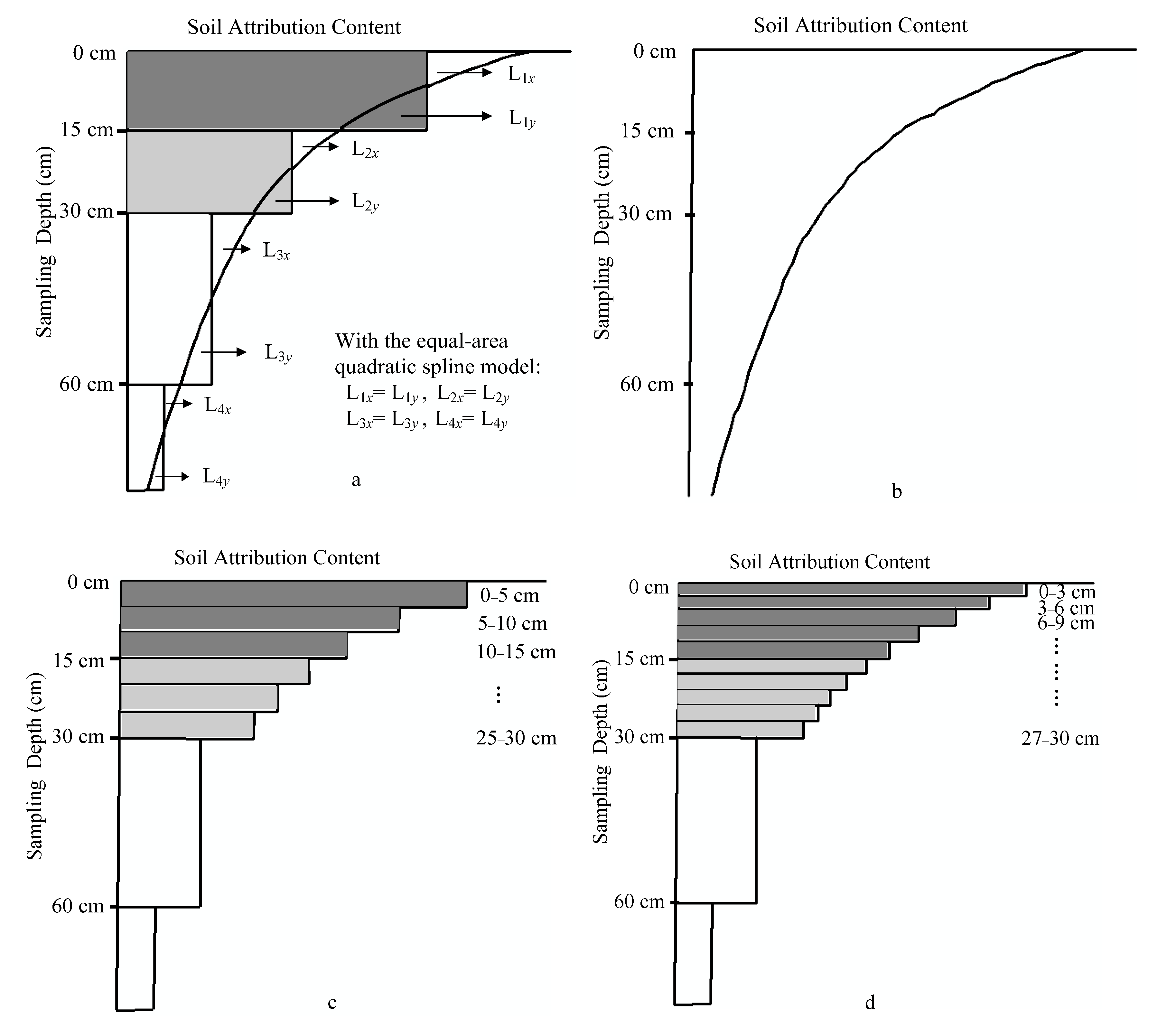
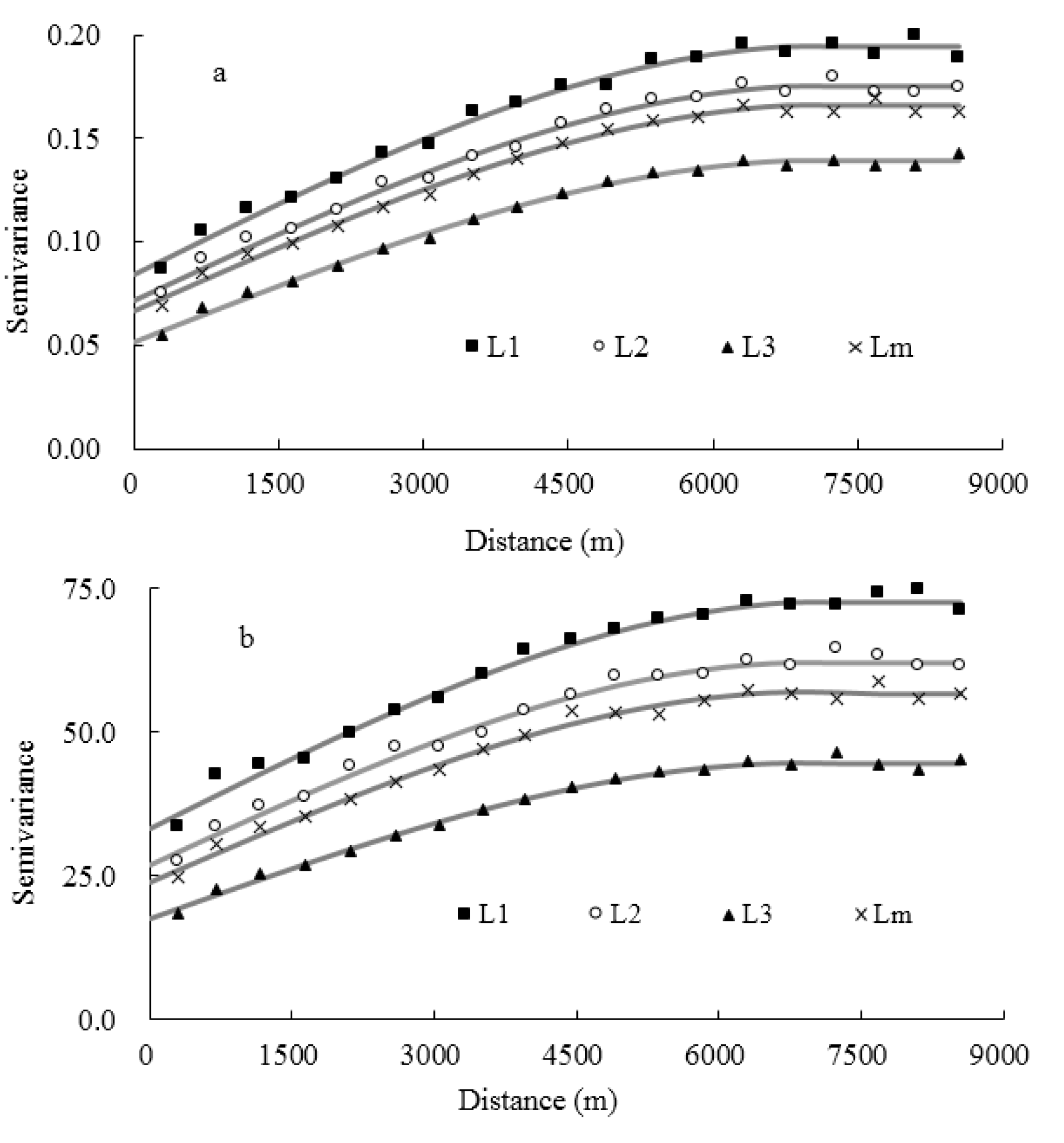
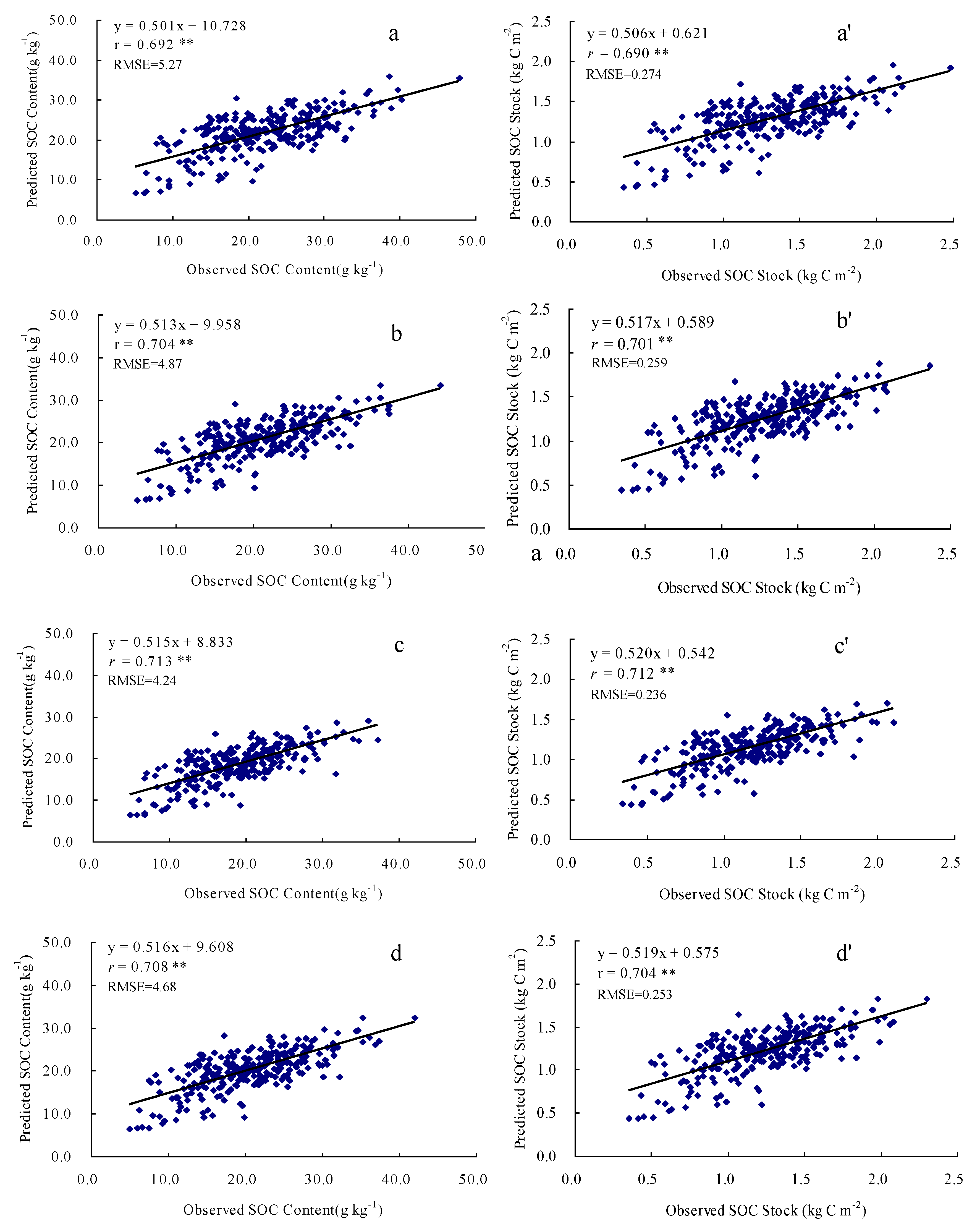
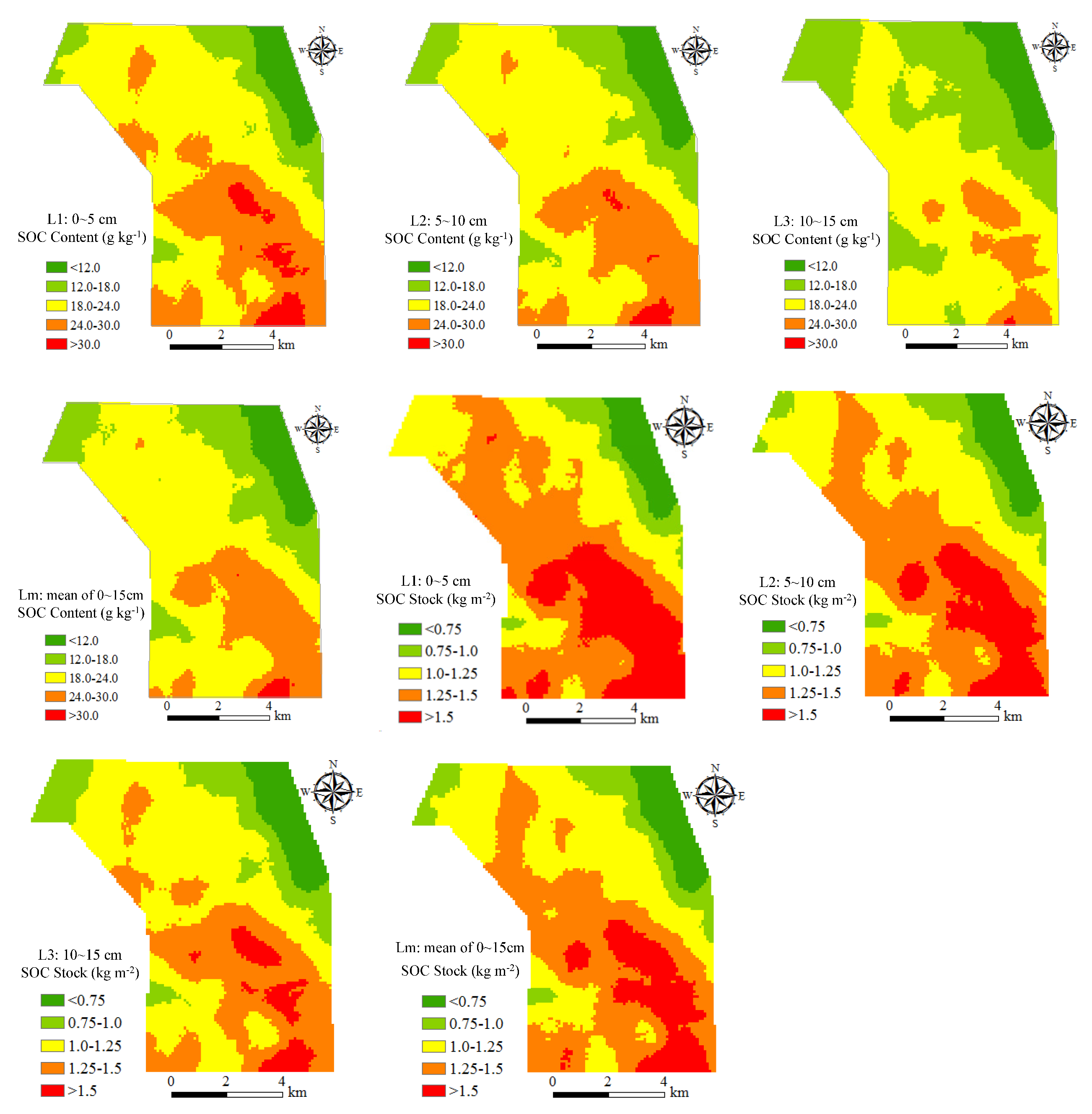
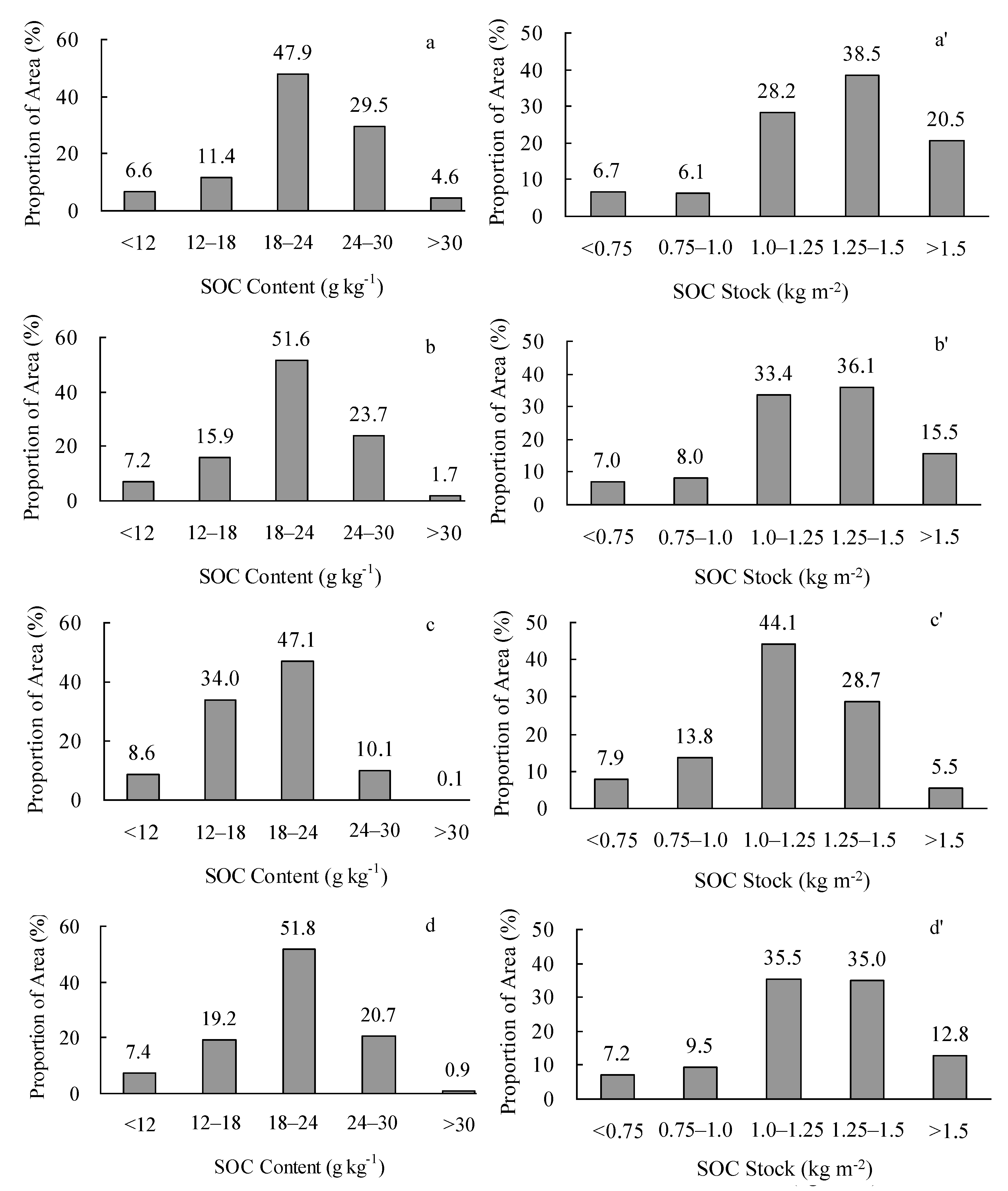
| Soil Series | Sampling Layer | Texture (USDA) | pH | Organic Matter g·kg−1 | CaCO3 % | CEC § Cmol(+)/kg |
|---|---|---|---|---|---|---|
| Shiushui Homei | Tillage layer | Silty clay loam | 7.7 | 20.2 b † | 1.20 | 16.7 |
| Tillage layer | Silt loam | 7.1 | 39.5 a | 0.40 | 17.6 |
| Parameters | Sub-Layers a | N b | Min. | Max. | Mean c | Std. d | CV e | Skewness | Kurtosis |
|---|---|---|---|---|---|---|---|---|---|
| SOC content | ---------------g·kg−1---------------- | ||||||||
| Lm | 646 | 3.02 | 51.7 | 20.5 b | 7.15 | 0.35 | 0.27 | 0.85 | |
| L1 | 646 | 1.03 | 56.6 | 22.1 a | 8.07 | 0.36 | 0.29 | 0.96 | |
| L2 | 646 | 2.74 | 53.4 | 21.0 b | 7.46 | 0.35 | 0.28 | 0.89 | |
| L3 | 646 | 2.99 | 46.7 | 18.7 c | 6.31 | 0.34 | 0.26 | 0.73 | |
| Bulk density | ---------------g·cm−3---------------- | ||||||||
| Lm | 646 | 1.05 | 1.42 | 1.22 a | 0.06 | 0.047 | 0.67 | 0.90 | |
| L1 | 646 | 1.01 | 1.43 | 1.19 ab | 0.06 | 0.054 | 0.71 | 1.10 | |
| L2 | 646 | 1.04 | 1.42 | 1.21 c | 0.06 | 0.049 | 0.68 | 0.97 | |
| L3 | 646 | 1.09 | 1.44 | 1.26 b | 0.05 | 0.042 | 0.59 | 0.67 | |
| SOC stock | --------------kg·m−2-------------- | ||||||||
| Lm | 646 | 0.21 | 2.72 | 1.23 b | 0.38 | 0.31 | 0.00 | 0.58 | |
| L1 | 646 | 0.073 | 2.86 | 1.29 a | 0.41 | 0.32 | −0.04 | 0.68 | |
| L2 | 646 | 0.194 | 2.77 | 1.25 ab | 0.39 | 0.31 | −0.01 | 0.61 | |
| L3 | 646 | 0.215 | 2.55 | 1.16 c | 0.35 | 0.30 | 0.03 | 0.48 | |
| Parameters | Sub-Layers a | Model | C0 | Sill | C0/Sill | Range (m) | R2 |
|---|---|---|---|---|---|---|---|
| SOC contents | Lm | Spherical | 24.0 | 57.1 | 42.0 | 6920 | 0.995 |
| L1 | Spherical | 33.4 | 72.9 | 45.8 | 6890 | 0.964 | |
| L2 | Spherical | 26.8 | 62.3 | 43.0 | 6950 | 0.906 | |
| L3 | Spherical | 17.8 | 44.9 | 39.6 | 7190 | 0.962 | |
| SOC stocks | Lm | Spherical | 0.066 | 0.17 | 38.8 | 7240 | 0.922 |
| L1 | Spherical | 0.084 | 0.20 | 42.0 | 7130 | 0.962 | |
| L2 | Spherical | 0.072 | 0.18 | 40.0 | 7180 | 0.912 | |
| L3 | Spherical | 0.052 | 0.14 | 37.1 | 7250 | 0.995 |
© 2020 by the authors. Licensee MDPI, Basel, Switzerland. This article is an open access article distributed under the terms and conditions of the Creative Commons Attribution (CC BY) license (http://creativecommons.org/licenses/by/4.0/).
Share and Cite
Zhang, Z.; Li, J.; Tsui, C.-C.; Chen, Z.-S. The Study of Gaining More Detailed Variability Information of Soil Organic Carbon in Surface Soils and Its Significance to Enriching the Existing Soil Database. Sustainability 2020, 12, 4866. https://doi.org/10.3390/su12124866
Zhang Z, Li J, Tsui C-C, Chen Z-S. The Study of Gaining More Detailed Variability Information of Soil Organic Carbon in Surface Soils and Its Significance to Enriching the Existing Soil Database. Sustainability. 2020; 12(12):4866. https://doi.org/10.3390/su12124866
Chicago/Turabian StyleZhang, Zhongqi, Jingzhang Li, Chun-Chih Tsui, and Zueng-Sang Chen. 2020. "The Study of Gaining More Detailed Variability Information of Soil Organic Carbon in Surface Soils and Its Significance to Enriching the Existing Soil Database" Sustainability 12, no. 12: 4866. https://doi.org/10.3390/su12124866
APA StyleZhang, Z., Li, J., Tsui, C.-C., & Chen, Z.-S. (2020). The Study of Gaining More Detailed Variability Information of Soil Organic Carbon in Surface Soils and Its Significance to Enriching the Existing Soil Database. Sustainability, 12(12), 4866. https://doi.org/10.3390/su12124866





